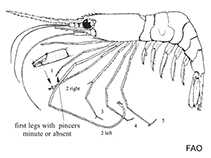Pandalus hypsinotus Brandt, 1851
Coonstriped shrimp| Native range | All suitable habitat | Point map | Year 2050 |

|
| This map was computer-generated and has not yet been reviewed. |
| Pandalus hypsinotus AquaMaps Data sources: GBIF OBIS |
muatnaik fotos/gambar
imej Google | No image available for this species;
drawing shows typical species in Pandalidae.
imej Google | No image available for this species;
drawing shows typical species in Pandalidae.
Classification / Names Common names | Synonyms | CoL | ITIS | WoRMS
Malacostraca | Decapoda | Pandalidae
Environment: milieu / climate zone / depth range / distribution range Ekologi
; kisaran kedalaman 5 - 501 m (Ref. 8). Temperate, preferred 5°C (Ref. 107945); 63°N - 33°N, 126°E - 122°W
Penyebaran Negara-negara | Daerah-daerah FAO | Ecosystems | Kemunculan | Introduksi
Northern Pacific and Northwest Atlantic: From Korea Strait, Japan and West Bering Sea to Kuril Islands, Gulf of Alaska and Puget Sound, Washington, USA.
Length at first maturity / Size / Weight / umur
Maturity: Lm ? range ? - ? cm Max length : 20.9 cm TL jantan/; (Ref. 8)
deskripsi pendek Morfologi
Known as "king", "rose", or "hump", it is superficially similar to P. danae except that it is blotched, redder in color and larger. As in P. danae the body is stout and the shell hard, but the surface is smooth and the carapace strongly arched dorsally. There are 17 to 22 dorsal spines which occupy the anterior three fifths of the carapace and extend an equal distance on the rostrum. The distal portion of the rostrum is strongly ascending and unarmed, except at the tip, which is oblique and armed with three immovable spines.
Maximum depth from Ref. 116014.
Life cycle and mating behavior Kematangan | Reproduksi, perkembang biakan | Pemijahan | telur-telur | Fecundity | Larva
Male yearlings (March-May) reach their sexual maturity by fall. Metamorphosis occur in spring and in shallow water (20-30 fathoms) around 2 years of age, females mature few months after (September) where spawning starts. Eggs were found by April (Ref. 82652).
rujukan utama
Acuan | Koordinator | mitra
Williams, A.B., L.G. Abele, D.L. Felder, H.H. Hobbs Jr., R.B. Manning, P.A. McLaughlin and I. Pérez Farfante. 1988. (Ref. 2214)
Status IUCN Red List (Ref. 130435: Version 2024-1)
status CITES (Ref. 108899)
Not Evaluated
CMS (Ref. 116361)
Not Evaluated
ancaman kepada manusia
penggunaan manusia
Perikanan: komersial
FAO - Perikanan: landings | FishSource | Sea Around Us
Alat, peralatan
informasi lanjut
Trophic Ecology
Ecology
Population dynamics
Pertumbuhan
Umur / Saiz
panjang-berat
panjang-panjang
ukuran frekuensi
Mass conversion
pemulihan
Kelimpahan
Umur / Saiz
panjang-berat
panjang-panjang
ukuran frekuensi
Mass conversion
pemulihan
Kelimpahan
Life cycle
Reproduksi, perkembang biakan
Kematangan
Fecundity
Pemijahan
telur-telur
pekembangan telor
Larva
Dinamika larva
Kematangan
Fecundity
Pemijahan
telur-telur
pekembangan telor
Larva
Dinamika larva
Distribution
Human Related
profil budidaya air
Stamps, Coins Misc.
Stamps, Coins Misc.
Outreach
References
Sumber internet
BHL | BOLD Systems | CISTI | DiscoverLife | FAO(Perikanan: ; publication : search) | Fishipedia | GenBank (genom, Nukleotida) | GloBI | Gomexsi | Google Books | Google Scholar | Google | PubMed | Tree of Life | Wikipedia (pergi, Cari) | Zoological Record
Estimates based on models
Preferred temperature
(Ref. 115969): 0.8 - 8.6, mean 4.3 (based on 501 cells).
Nutrients : Calcium = 109 [35, 184] mg/100g; Iron = 1.59 [1.21, 1.97] mg/100g; Protein = 20.2 [19.2, 21.3] %; Omega3 = 0.285 [0.185, 0.386] g/100g; Selenium = 48.3 [-31.7, 128.3] μg/100g; VitaminA = 0 μg/100g; Zinc = 1.79 [1.17, 2.40] mg/100g (wet weight); based on nutrient studies.



